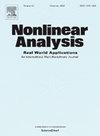具有信号依赖扩散和灵敏度的趋化性斑秃模型的全局和指数稳定性
IF 1.8
3区 数学
Q1 MATHEMATICS, APPLIED
引用次数: 0
摘要
本文研究了一种具有信号依赖扩散和敏感性的三组分趋化模型在非传染性自身免疫性疾病斑秃(AA)中的大时间行为。该模型描述了CD4+ T细胞、CD8+ T细胞和干扰素-γ (IFN-γ)之间复杂的相互作用。首先,我们利用加权能量估计的方法,建立了当非线性扩散率比密度相关死亡率小时系统经典解的均匀有界性。然后,当非线性扩散率和密度相关死亡率在一定范围内,且信号相关灵敏度相对于信号相关扩散较小时,证明了正平衡的全局指数渐近稳定性。最后,进行了数值模拟,从两个空间维度揭示了系统的时空动态。研究表明,如果信号依赖性趋化效应较弱,病变毛囊(HFs)内或周围会出现稀疏且均匀的无毛斑块,并最终诱导稳定的AA。本文章由计算机程序翻译,如有差异,请以英文原文为准。
Global and exponential stabilization of a chemotactic alopecia areata model with signal-dependent diffusion and sensitivity
This paper focuses on the large time behavior of a three-component chemotaxis model with signal-dependent diffusion and sensitivity for alopecia areata (AA) which is a noncontagious autoimmune disorder. The model describes the complex interactions among the CD T cells, CD T cells and interferon-gamma (IFN-). Firstly, we use a method of weighted energy estimates to establish the uniform-in-time boundedness of classical solutions for the system when nonlinear proliferation rate is small compared with density-dependent death rates. Then, the globally exponentially asymptotic stability of positive equilibrium is proved if nonlinear proliferation rate and density-dependent death rates are within a particular range, and signal-dependent sensitivities are small relative to signal-dependent diffusions. Finally, some numerical simulations are performed to reveal the spatio-temporal dynamics of system in two space dimensions. It is shown that sparse and homogeneous hairless patches occur in or around diseased hair follicles (HFs) and eventually induce a stable AA if signal-dependent chemotactic effect is weak.
求助全文
通过发布文献求助,成功后即可免费获取论文全文。
去求助
来源期刊
CiteScore
3.80
自引率
5.00%
发文量
176
审稿时长
59 days
期刊介绍:
Nonlinear Analysis: Real World Applications welcomes all research articles of the highest quality with special emphasis on applying techniques of nonlinear analysis to model and to treat nonlinear phenomena with which nature confronts us. Coverage of applications includes any branch of science and technology such as solid and fluid mechanics, material science, mathematical biology and chemistry, control theory, and inverse problems.
The aim of Nonlinear Analysis: Real World Applications is to publish articles which are predominantly devoted to employing methods and techniques from analysis, including partial differential equations, functional analysis, dynamical systems and evolution equations, calculus of variations, and bifurcations theory.

 求助内容:
求助内容: 应助结果提醒方式:
应助结果提醒方式:


